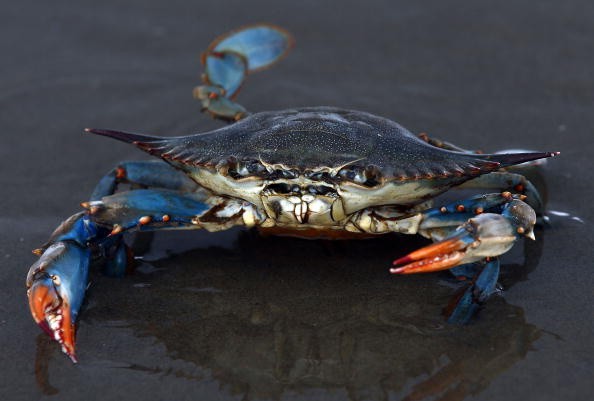A rare crustacean is the new sightseeing star at a Maryland science museum: a Chesapeake blue crab that's partly male, partly female.

Bilateral Gynandromorphy
This crab, which has an extremely uncommon condition referred to as bilateral gynandromorphy, is approximately 4-and-a-half inches long and evaluated to be in its third year. It possesses both red and blue-tipped claws and an underbelly, or apron, that is split right down the center.
Generally, male blue crabs possess blue claw tips and a T-shaped apron, while females possess red tips and a wide apron. In at least 15 years, a gynandromorphic crab hasn't been reported on the Eastern Seaboard. Chesapeake Bay Magazine reported that Waterman Jerry Smith captured the newest one.
Instead of throwing it in his catch, Smith, a crabber for over four decades, gave it away to the Delmarva Discovery Museum, where it now gets to lounge all over in its own 70-gallon tank.
Jimmy Vs. Sook
According to Virginia Institute of Marine Science (VIMS), in a 'Jimmy', or a male blue crab, the underbelly is pointed 'like the Washington Monument,' while the claws are a deep blue. In a 'sook,' or a female, the pincers are pinkish and the underbelly is rounded, 'like the Capitol dome'.
An expert in animal husbandry at the Delmarva Discovery Museum, September Meagher, told DailyMail.com the male claw is bluer and the female claw is less blue and tipped with red. Meagher said: "Our crab's claws are not showing this as clearly, but we are identifying it more and more every day as it settles into its new abode and receives nutrient-rich meals."
Bilateral gynandromorphy, when the division of characteristics is split down the middle, often arises very early in the development of an organism, when it possess just between 8 and 64 cells. Meagher said this condition is a cellular aberration that is believed to take place when the crab is still in its egg form.

Breeding and Sexual Development in Blue Crabs
A cell doesn't split its sex chromosomes in the usual fashion at some point, bringing about uneven distribution of sexual characteristics, from coloring to reproductive organs. It is dissimilar to 'hermaphroditism,' when just the sex organs are impacted. Bilateral gynandromorphism doesn't take place in mammals, but has been noticed in lobsters, butterflies, crabs, bees, snakes, chickens, and other birds.
It can possibly be impacted by water temperature or hormone levels inside the womb of the mother. Marine biologists at VIMS are researching the uncommon genetic condition to get a better understanding of breeding and sexual development in blue crabs, according to Meagher.
The creatures were formerly a major economic driver in the area but their numbers have reduced because of overfishing and pollution. She said it is believed that they don't have the ability of reproducing with themselves, as a hermaphrodite is at times able, but that they might be a possible mate for another crab.
For more news, updates about crabs and similar topics don't forget to follow Nature World News!
© 2025 NatureWorldNews.com All rights reserved. Do not reproduce without permission.





